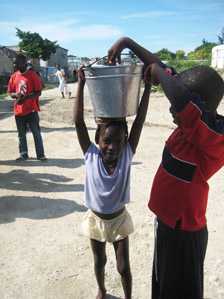Six Basic Cholera Prevention Messages

A girl carrying a pail of water.
Download Fact Sheet: Five Basic Cholera Prevention Messages [PDF - 2 pages]
The risk for cholera is very low for people visiting areas with epidemic cholera. When simple precautions are observed, contracting the disease is unlikely.
All people (visitors or residents) in areas where cholera is occurring or has occurred should be aware of the basic cholera facts and observe five basic cholera prevention recommendations 1, 2.
Protect Yourself from Cholera
1. Drink and use safe water*
- Bottled water with unbroken seals and canned/bottled carbonated beverages are safe to drink and use.
- Use safe water to brush your teeth, wash and prepare food, and to make ice.
- Clean food preparation areas and kitchenware with soap and safe water and let dry completely before reuse.
To be sure water is safe to drink and use:
- Boil it or treat it with a chlorine product or household bleach.
- If boiling, bring your water to a complete boil for at least 1 minute.
- To treat your water with chlorine, use one of the locally available treatment products and follow the instructions. For a list of products distributed by country, visit CDC’s Safe Water System website.
- If a chlorine treatment product is not available, you can treat your water with household bleach. Add 8 drops of household bleach for every 1 gallon of water (or 2 drops of household bleach for every 1 liter of water) and wait 30 minutes before drinking.
- Always store your treated water in a clean, covered container.
*Piped water sources, drinks sold in cups or bags, or ice may not be safe and should be boiled or treated with chlorine.
2. Wash your hands often with soap and safe water*
- Before you eat or prepare food
- Before feeding your children
- After using the latrine or toilet
- After cleaning your child’s bottom
- After taking care of someone ill with diarrhea
* If no soap is available, scrub hands often with ash or sand and rinse with safe water.
3. Use latrines or bury your feces (poop); do not defecate in any body of water
- Use latrines or other sanitation systems, like chemical toilets, to dispose of feces.
- Wash hands with soap and safe water after defecating.
- Clean latrines and surfaces contaminated with feces using a solution of 1 part household bleach to 9 parts water.
What if I don’t have a latrine or chemical toilet?
- Defecate at least 30 meters (98 ft) away from any body of water and then bury your feces.
- Dispose of plastic bags containing feces in latrines, at collection points if available, or bury it in the ground. Do not put plastic bags in chemical toilets.
- Dig new latrines or temporary pit toilets at least a half-meter (1.6 ft) deep and at least 30 meters (98 ft) away from any body of water.
4. Cook food well (especially seafood), keep it covered, eat it hot, and peel fruits and vegetables*
- Boil it, Cook it, Peel it, or Leave it.
- Be sure to cook shellfish (like crabs and crayfish) until they are very hot all the way through.
*Avoid raw foods other than fruits and vegetables you have peeled yourself.
5. Clean up safely—in the kitchen and in places where the family bathes and washes clothes
- Wash yourself, your children, diapers, and clothes, 30 meters (98 feet) away from drinking water sources.
6. Consider getting vaccinated before you travel
The FDA recently approved a single-dose live oral cholera vaccine called Vaxchora. Vaxchora is recommended for adults who are 18 – 64 years old and are traveling to an area of active cholera transmission with toxigenic Vibrio cholerae O1 (the bacteria strain that most commonly causes cholera) to prevent infection. For more information, please visit the Vaccines page.
For more information, please visit the following pages.
References
- Tappero JW, Tauxe RV. Lessons learned during public health response to cholera epidemic in Haiti and the Dominican Republic. Emerg Infect Dis. 2011;17(11):2087-93.
- Waldman RJ, Mintz ED, Papowitz H. The cure for cholera – improving access to safe water and sanitation. N Engl J Med. 2013. DOI: 10.1056/NEJMp1214179
- Page last reviewed: November 9, 2016
- Page last updated: November 9, 2016
- Content source:


 ShareCompartir
ShareCompartir